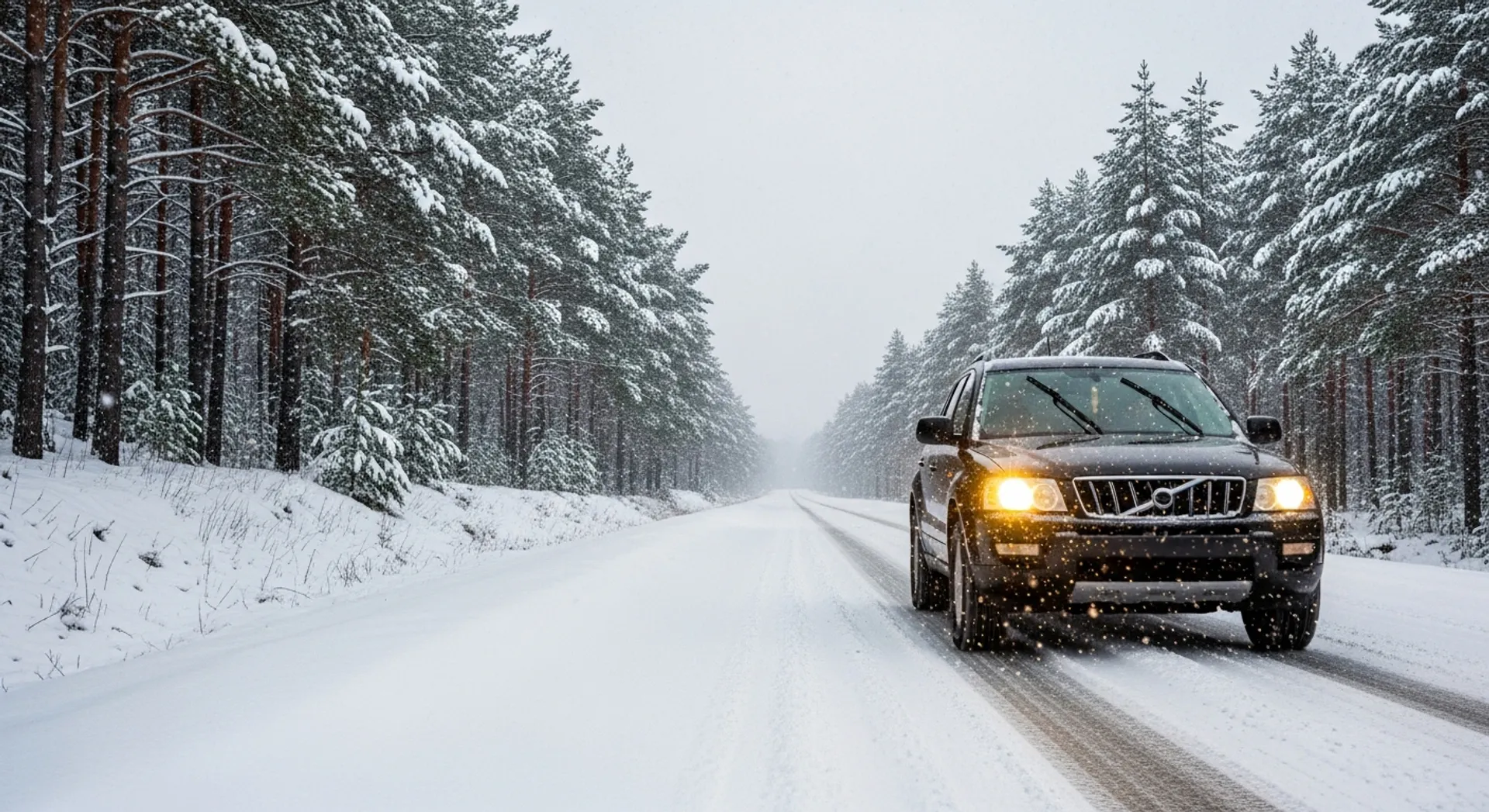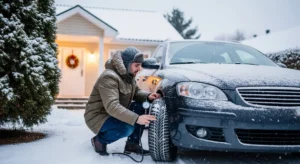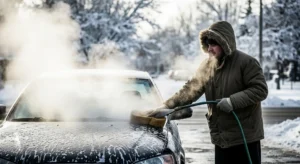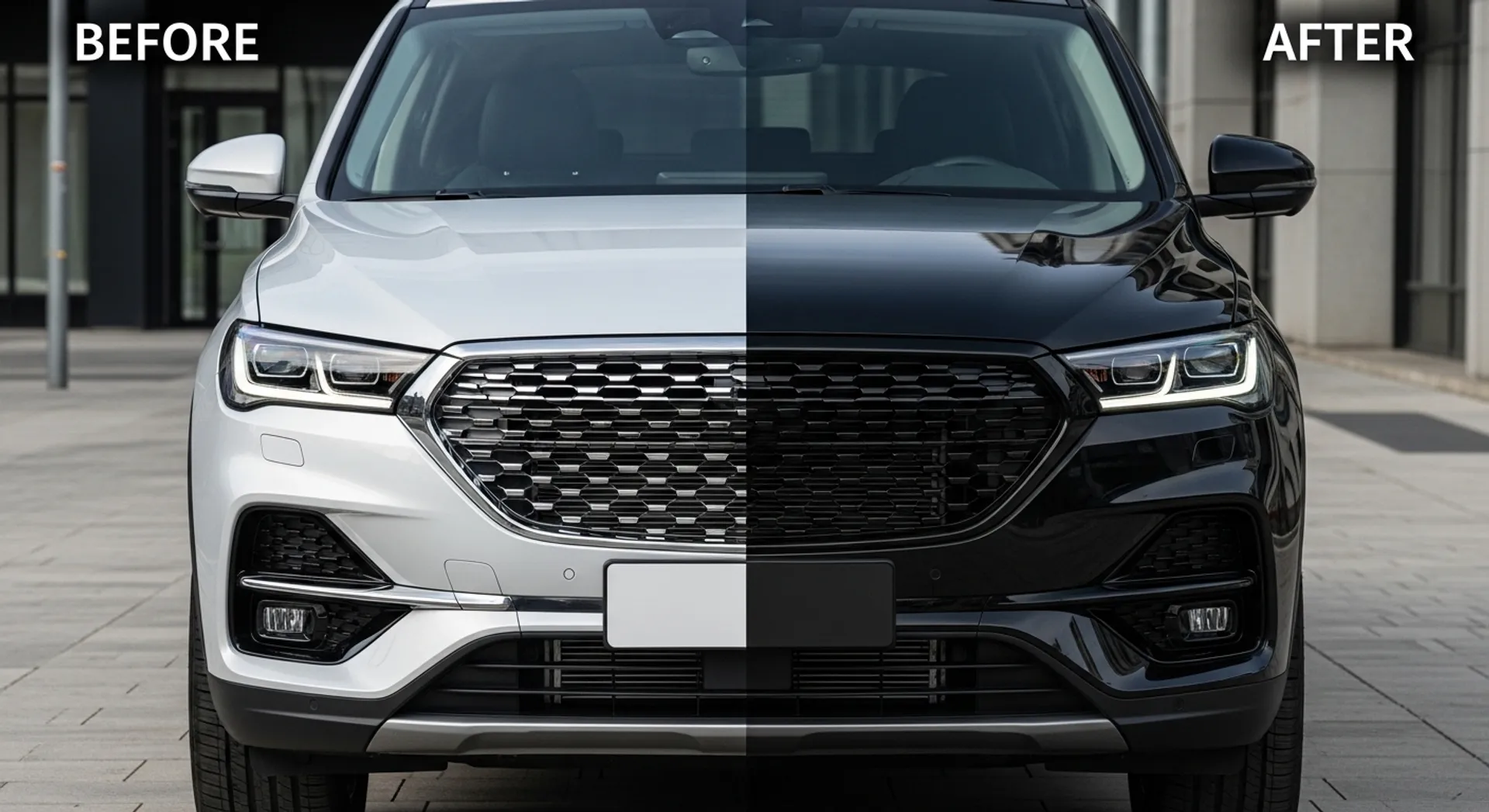Winter roads bring their own set of hazards — icy surfaces, reduced visibility, and frigid temperatures can test even the most reliable vehicles. This “Seasonal auto care tips: preparing your car for winter” is about more than just convenience; it’s about safety and peace of mind for you and your passengers. By focusing on proactive winter car maintenance, you reduce the risk of breakdowns and accidents when conditions are at their worst.
Taking steps early means you’re not left scrambling after the first snowstorm or cold snap.
This guide delivers practical seasonal auto care tips designed to keep your vehicle running smoothly all season long. From inspecting your battery to swapping out tires and assembling an emergency kit, each section covers a critical aspect of preparing your car for winter. You’ll find actionable advice to ensure safe winter driving, no matter how harsh the weather gets.
1. Comprehensive Vehicle Inspection Before Winter
Conducting a thorough winter vehicle inspection is crucial for ensuring your car’s reliability and safety during the colder months. Focus on critical components to prevent unexpected breakdowns and enhance performance in icy conditions.
Battery Check
Cold weather can significantly reduce battery capacity. Perform load tests to gauge its health and inspect terminals for corrosion or damage. Replacing an old or weak battery can prevent starting issues on freezing mornings.
Cooling System
Ensure the cooling system is in top condition by checking antifreeze levels and inspecting hoses for leaks or cracks. A properly functioning cooling system keeps the engine from overheating, even in frigid temperatures.
Brake System Maintenance
Icy roads demand optimal brake performance. Inspect brake pads, rotors, and fluid levels. Address any wear or issues immediately to maintain effective stopping power and avoid accidents.
Belts and Hoses
Examine belts and hoses for signs of wear, such as cracks or fraying. These components are susceptible to failure in cold weather, leading to potential engine damage or breakdowns.
Spark Plugs, Wires, and Cables
Check spark plugs, wires, and cables for wear or damage. Faulty ignition components can cause poor engine performance, especially when dealing with cold starts.
By prioritizing these inspections, you ensure that your vehicle remains dependable and safe throughout the winter season. Additionally, it’s important to remember that just as winter car maintenance is crucial, so too is summer car maintenance when the seasons change.
2. Tire Maintenance for Winter Conditions
Winter tires and snow tires play a critical role in maintaining control when roads turn slick with snow or ice. All-season tires lose flexibility and grip as temperatures drop, while winter tires are engineered with softer rubber compounds and special tread patterns to maximize traction even in subzero conditions.
Switching to winter or snow tires
If you live in an area prone to heavy snowfall or consistently cold temperatures, switching to dedicated winter tires is one of the most effective safety upgrades you can make. These tires outperform all-seasons by providing better braking and handling on icy surfaces.
Tire pressure maintenance
Tire pressure drops about 1 PSI for every 10°F decrease in temperature. Underinflated tires reduce traction, wear unevenly, and increase stopping distances. Check your tire pressure at least once a month during winter, using the recommended PSI listed in your owner’s manual or on the driver’s door jamb.
Tire tread depth and wear
Adequate tread depth is essential for channeling slush and expelling water. Use a tread depth gauge or the penny test—if Lincoln’s head remains visible, it’s time for new tires. Look for uneven wear patterns, cuts, or embedded debris that could compromise performance.
When to replace tires
Replace any tire with less than 4/32” of tread or visible damage before winter hits. Worn-out tires are especially hazardous on snowy or icy roads where stopping distances increase dramatically.
Consistent attention to your vehicle’s tires ensures you’re not caught off guard by the first freeze or flurry of the season, keeping your handling sharp when you need it most.
3. Windshield and Visibility Preparations
Preparing your windshield and maintaining visibility are critical to safe winter driving. Start by replacing windshield wipers with rubber-clad blades designed to prevent ice buildup. These wipers are more durable and effective in harsh weather conditions.
Use freeze-resistant or antifreeze windshield washer fluids to ensure that your washer system functions properly even in freezing temperatures. Regular windshield washer fluid can freeze, making it impossible to clear your windshield of snow, ice, or road grime.
Verify that your heater, defroster, and air conditioning systems are in good working order. The heater ensures comfort, while the defroster and air conditioning help keep your windows clear of fog and frost. This is essential for maintaining unobstructed views during winter drives.
Ensure that the rear-window defrosters are functional as well. Rear-window defrosters are crucial for eliminating ice and condensation on your rear window, providing you with a clear view of traffic behind you.
By focusing on these key areas, you enhance visibility and safety during winter driving conditions. Properly maintained visibility systems allow you to react better to changing road conditions and potential hazards, contributing to a safer driving experience.
4. Engine and Fluid Care for Cold Weather
Cold weather can significantly impact your vehicle’s engine performance and fluid levels. Here are the key steps to ensure your car is well-prepared:
1. Change engine oil to a thinner grade suited for cold temperatures
When temperatures drop, the viscosity of engine oil thickens, making it harder for the oil to flow and lubricate the engine effectively. Switching to a thinner grade oil, such as 5W-30 or even 0W-20, can help improve engine performance and reduce wear during cold starts.
2. Inspect the cooling system and ensure proper antifreeze levels
The cooling system is crucial for preventing the engine from freezing or overheating. Check the coolant levels and top up with a 50/50 mixture of antifreeze and water, which provides optimal protection against freezing and boiling. Consider having a professional inspect hoses, belts, and the radiator for any signs of wear or leaks.
3. Maintain other fluid levels suitable for winter conditions
Transmission fluid, brake fluid, power steering fluid, and windshield washer fluid should all be checked and maintained at appropriate levels. Use freeze-resistant windshield washer fluids to prevent freezing in the reservoir and nozzles.
Regularly monitoring these elements ensures your vehicle operates smoothly throughout the winter months. Keeping up with this maintenance can prevent costly repairs and ensure you stay safe on the road.
5. Exterior Care and Corrosion Prevention
Winter car washing isn’t just about looks — it’s a defense against rust and long-term damage. Road salt, magnesium chloride, and other de-icing chemicals quickly accumulate on your vehicle’s exterior, especially after snowstorms or slushy commutes. These substances are highly corrosive and can eat through paint, undercarriage metal, brake lines, and suspension components.
Key strategies for corrosion prevention:
- Wash your vehicle frequently: Aim for at least once every one to two weeks during winter. Focus on days when temperatures are above freezing to prevent doors or locks from freezing shut.
- Pay special attention to the undercarriage and wheel wells: These areas collect the most grime and salt. Use high-pressure washers or specialized undercarriage sprays at self-serve car washes to target hard-to-reach spots.
- Don’t neglect door jambs, hinges, and trunk edges: Salt can work its way into these crevices, increasing the risk of hidden rust.
- Apply a quality wax or sealant before winter sets in: This extra layer offers additional protection against corrosive elements.
- Inspect for chips or scratches in paintwork: Touch up any damaged areas promptly to prevent moisture infiltration and rust formation.
Maintaining a clean exterior extends your vehicle’s lifespan and preserves resale value. Regular winter car washing is not just cosmetic—it’s essential road salt removal that keeps corrosion at bay. Protecting exposed metal and maintaining a clear finish ensures your car looks better and lasts longer through harsh conditions.
6. Emergency Preparedness for Winter Driving
Staying prepared during the colder months means assembling a winter emergency kit that covers a range of unexpected situations. Harsh weather can leave you stranded for hours, so having the right car safety supplies for winter is non-negotiable.
Essentials for Your Winter Emergency Kit:
- Warmth and Visibility: Pack blankets or sleeping bags, hand warmers, and extra gloves. Flares or reflective triangles help signal your location in low visibility.
- Basic Tools: A sturdy jack, lug wrench, and a collapsible shovel are must-haves for digging out of snowbanks or performing minor repairs.
- First-Aid Supplies: Stock bandages, antiseptic wipes, pain relievers, and any personal medications.
- Light and Power: Keep a flashlight with extra batteries or a hand-crank model; consider a power bank for charging devices.
- Food and Water: High-energy snacks like granola bars and bottled water ensure you stay nourished.
Traction Aids:
Include kitty litter or sand — these provide instant traction if your tires spin on ice or slick surfaces. Just sprinkle some under the drive wheels to help get moving again.
Fuel Management:
Keeping your gas tank at least half full prevents fuel line freeze-up and provides enough fuel to keep the heater running if you’re stuck. This precaution is essential for both stranded preparedness and peace of mind during long winter drives.
Preparing with these seasonal auto care tips means that even if conditions turn severe, you remain safe and self-reliant until help arrives. Next, focus turns to mastering driving techniques that minimize risk on icy roads.
7. Safe Winter Driving Techniques
Driving in winter requires a shift in habits and awareness to adapt to unpredictable conditions. These winter driving safety tips can make a significant difference:
Adjust Speed for Road Conditions
Reducing speed is non-negotiable on snow or ice. Even if the road looks clear, black ice can catch you off guard. Lower your speed below posted limits when surfaces are slick or visibility drops.
Increase Stopping Distance in Ice Conditions
Stopping distances can triple or quadruple on icy roads compared to dry pavement. Leave at least eight to ten seconds between your vehicle and the one ahead. This extra buffer provides the space needed for safe braking.
Handling Skids in Snow
If your car starts to skid, remain calm. Ease off the accelerator and steer gently in the direction you want the front wheels to go — avoid slamming on the brakes, which can worsen the skid. For rear-wheel skids, turn into the slide until you regain control.
Uphill and Downhill Techniques
When climbing a hill, apply steady pressure to the accelerator to maintain momentum without spinning tires. Avoid stopping halfway up. For descents, shift into a lower gear early and brake gently; excessive braking can lead to loss of control.
Preparation is essential, but technique behind the wheel makes all the difference when conditions turn treacherous.
Conclusion
Taking care of your car in winter is a smart move. It not only gives you peace of mind but also keeps you safe when the temperatures drop. By getting ready ahead of time, you can avoid any surprises when ice and snow make driving tricky.
Here’s what you need to do:
- Check your vehicle thoroughly
- Make sure your tires are ready
- Don’t forget about visibility and fluid checks
Also, remember to wash off any harmful road chemicals and pack an emergency kit that has everything you might need.
Benefits of winter car care
Here are some reasons why it’s worth investing time and effort into winter car care:
- More reliable vehicle performance in cold weather
- Better grip on the road, shorter stopping distances, and clearer vision while driving
- Lower chances of breakdowns or accidents
- Longer lifespan for your vehicle and higher resale value
The advantages of seasonal auto maintenance are obvious: safer trips for you and your passengers, even in unpredictable weather conditions.
This “Seasonal Auto Care Tips: Preparing Your Car for Winter” is more than just a list of things to do — it’s a promise to yourself that you’ll drive confidently during winter. So take action early, stay prepared, and look forward to smooth journeys no matter what winter throws at you.






